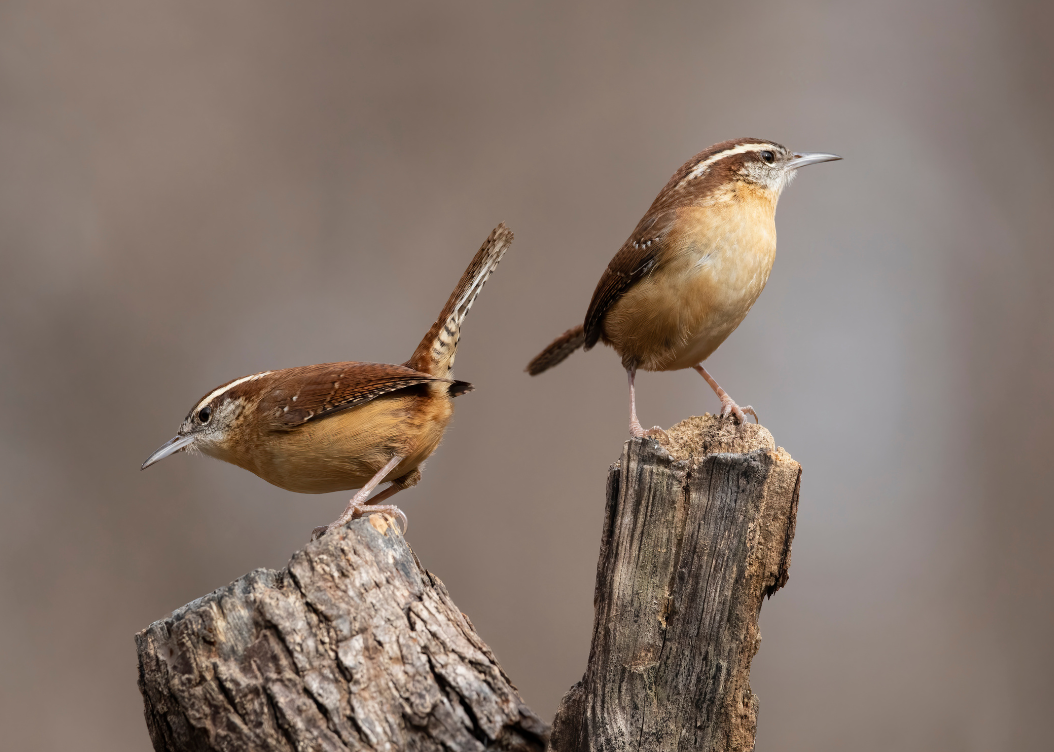Scientific Name: Troglodytidae
– Order: Passeriformes
Common Names
– Wrens
Description
Wrens are small, brownish passerine birds characterized by their upbeat tail position and bustling behavior. They generally have compact bodies, pointed bills, and strong legs. Most wrens are unassuming in coloration, ranging from gray to brown, with some species showing subtle barring or speckling. They vary significantly in size across different species, from the tiny Winter Wren at about 3.5 inches in length to the Giant Wren at nearly 8.5 inches.
Distribution and Habitat
Wrens are found predominantly in the Americas, with the greatest diversity in Central and South America. They inhabit a wide range of environments, from dense forests to arid scrublands. Their adaptability to different habitats, including urban areas, has allowed them to thrive in a variety of conditions.
Behavior
Wrens are known for their loud and often complex songs, disproportionate to their small size. They are generally solitary or found in pairs and are highly territorial during the breeding season. Many species are sedentary, while some northern species migrate seasonally.
Diet
Their diet primarily consists of insects and spiders. They forage for food in dense vegetation, using their sharp bills to extract prey from crevices.
Reproductive Information
Wrens typically nest in cavities, which they fill with a large mass of twigs and line with finer materials. Some species are known for building several “dummy” nests that are used to attract females and may serve as decoys to protect the actual nesting site. Clutch sizes vary by species, generally ranging from 3 to 10 eggs, which are incubated for about two weeks.
Conservation Status
While most wren species are of least concern, some are threatened or endangered due to habitat loss and fragmentation.
Ecological Role
Wrens contribute to insect population control in their habitats, which helps maintain ecological balance. Their nesting habits also contribute to the ecology of their habitats, as they often reuse materials and impact the structure of small vegetation.
Research and Observation
Studies on wrens have often focused on their vocalizations and breeding behaviors. Their ability to adapt to various environments also makes them a subject of interest in studies of urban ecology and the impacts of habitat alteration.
Management Strategies
Conservation efforts for wrens include habitat preservation and restoration, especially in areas where urban development threatens their natural environments. Programs that encourage the protection of natural vegetation can be beneficial for wren populations.
The Wren Family
Wrens have numerous subspecies across different geographical locations, adapting unique characteristics suited to their environments. By noticing these adaptations, we gain insights into the resilience and evolutionary paths of wrens in their diverse environments. This information is crucial for targeted conservation efforts and for understanding the ecological roles of these spirited songbirds. The following are some the subspecies we typically see in the Western United States:
House Wren (Troglodytes aedon): This widely spread species has numerous subspecies across North and South America. Differences among these subspecies can be subtle but often involve variations in song, size, and nesting habits.
Bewick’s Wren (Thryomanes bewickii): This wren has several subspecies across the western U.S., each adapted to different types of habitats ranging from coastal areas to dry, inland regions. For example, the Thryomanes bewickii spilurus subspecies is commonly found along the Pacific coast and is characterized by its darker, more defined plumage compared to those found in arid inland areas like the Thryomanes bewickii eremophilus of the Great Basin, which displays lighter coloring. Bewick’s Wrens are highly adaptable and known for their loud, complex songs that vary slightly between subspecies, reflecting their diverse habitats and the unique ecological niches they occupy.
Rock Wren (Salpinctes obsoletus): Found in rocky outcrops and cliff sides throughout the western mountains and deserts, the Rock Wren exhibits relatively uniform morphology across its range, but its behaviors can vary significantly depending on altitude and rockiness of the habitat. This species is well-adapted to sparse, stony environments where it feeds on insects extracted from crevices in the rocks.
Cactus Wren (Campylorhynchus brunneicapillus): The Cactus Wren, distinguished by its large size among the wrens, has a brown crown and heavily spotted white and black plumage that serves as camouflage in its native desert habitat. This wren is native to the arid south-western United States and Mexico, particularly thriving in areas dominated by cactus, scrub, and open sandy landscapes where it often uses cholla cactus and other thorny plants for nesting. The nest is an elaborate structure, larger than those of most other wrens, shaped like a football, and made from grass and plant fibers. It features a side entrance and is often placed in a cactus to deter predators. As the state bird of Arizona, the Cactus Wren is emblematic of the Southwestern desert. Its diet primarily includes insects, spiders, and occasionally seeds and fruits, reflecting its adaptation to the harsh desert environment where water and green vegetation are limited. The Cactus Wren’s song is a loud and harsh rasp, which can be heard at great distances across its arid habitat.
Marsh Wren (Cistothorus palustris): The Marsh Wren is a small, secretive bird that inhabits freshwater wetlands across North America. This bird is characterized by its bold black-and-white striped back and a plain brown cap, with a loud and distinctive song that often includes a variety of trills and gurgles. It builds its nest in the dense vegetation of marshes, weaving it into the surrounding reeds or cattails, which provides protection from predators. The Marsh Wren’s diet consists mainly of insects and spiders, which it picks from the stems and leaves of wetland vegetation. This wren is particularly noted for its aggressive territorial behavior; males often destroy the eggs of neighboring birds to reduce competition for food.
Canyon Wren (Catherpes mexicanus): The Canyon Wren inhabits rocky outcrops and steep cliffs in the arid landscapes of the western United States. This wren is easily recognized by its beautiful descending song that echoes through the canyons it calls home. Its plumage is a rusty brown that blends seamlessly into its rocky surroundings, helping it avoid predators. The Canyon Wren’s long, curved bill is perfectly adapted for extracting insects and spiders from crevices in the rocks. Unlike many wrens, the Canyon Wren does not often venture into open areas, preferring the seclusion and vertical faces of rocky canyons, where it can also nest in small crevices, using feathers and plant material to line the nest.
How to Attract Wrens to Your Property
1. Provide Nesting Boxes: Small, hole-fronted birdhouses are ideal for wrens and can encourage them to nest on your property.
2. Maintain a Natural Garden: Keeping areas of your garden wild with dense bushes and shrubs can provide foraging grounds and nesting sites.
3. Offer Food: During the winter, suet and small seeds can attract wrens that remain in colder climates.
4. Water Sources: A shallow, clean water source can be attractive to wrens for drinking and bathing.
5. Limit Chemical Use: Reducing pesticide use helps ensure a healthy supply of insects for wrens to feed on.
Click “Buy a Nestbox” below to start making your property a suitable habitat for the Wrens in your area.
To learn more about Wrens, check out:


